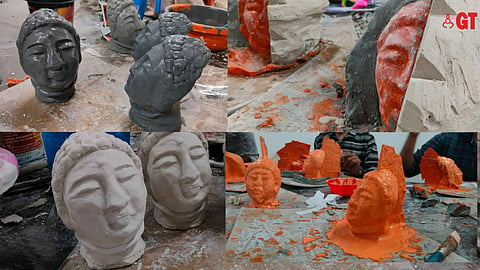

VRUTHA KARMALI
The art of restoration and reproduction is essential to preserve age-old artefacts, which embody cultural and historical significance. It plays a vital role, especially in archaeology and museology.
Last week, Goa's Directorate of Museums organised a five-day workshop on ‘Modelling and casting of PoP Replicas of Museum Antiquities’ aimed at letting people understand and experience the process of preserving and replicating historical sculptures.
“Originally this workshop was supposed to be held during summer holidays in May, but because of unforeseen circumstances it was pushed to July," says Sandip Majik, the guest lecturer at the museum and the main coordinator of the skill-building session.
Throwing light on the target audience, he added; "the workshop was targeted towards art enthusiasts, especially, students specialising in subjects related to arts and craft as well as artists/ crafts-persons like for instance those involved in Ganpati idol making”.
While detailing the goal of the workshop, Majik explained, “The main objective behind organising this workshop was to open more doors to people interested in this field. I hope to see some of our participants pursue this art form professionally and make the best use of the skills they have acquired here.”
The workshop was headed by Sadashiv Parab, a well-known internationally trained craftsman who has worked at the Directorate of Museums for over 30 years as a modeller and a restorer.
“The process of creating a replica involves thorough research of the monument, its history and overall a lot of study goes into it,” mentioned Parab. Throughout his career, he has restored and repaired various stone sculptures and museum antiquities. A part of his job was to create exact replicas of the artefacts - a skill he shared with his students at the workshop.
One of the antiquities chosen for replication was an ancient figure of the head of Buddha. “During the workshop, we were told that the figure of Buddha is an antiquity found in the 4th century and originally, it was a two-inch sculpture which we created a replica of.
The process of creating a replica involves thorough research of the monument, its history and overall a lot of study goes into it.
Sadashiv Parab, head of the workshop.
That feeling of being connected with some kind of art was intense - through and through. It was a beautiful experience,” expressed Sharayu Wadekar, an architectural historian who participated in the workshop.
While discussing the skills taught during the workshop, Sarah D’souza, a history student and an attendee of the modelling session, shared, “The five-day workshop included learning about different materials and techniques used in modelling."
We were taught everything in detail despite the short amount of time. Being patient and meticulous are essential skills required for clay modelling.
Sarah D’souza, a history student and participant.
She added, "From making a clay model of the object given to us to creating a rubber mould of the same and then using it to create a plaster of Paris model, we were taught everything in detail despite the short amount of time. Being patient and meticulous are essential skills required for clay modelling.”
This workshop shed light on the extensive research that goes into preserving and replicating museum monuments which in turn preserve our cultural heritage.
This workshop shed light on the extensive research that goes into preserving and replicating museum monuments which in turn preserve our cultural heritage.
This was a great opportunity for people to learn about history and the art of modelling in an interactive and engaging manner. The Directorate of Museums aims at organising more of these workshops to encourage young talents and art enthusiasts to learn new skills and widen their career options. If you wish to learn more of history and museum antiquities, do visit the Directorate of Museums.